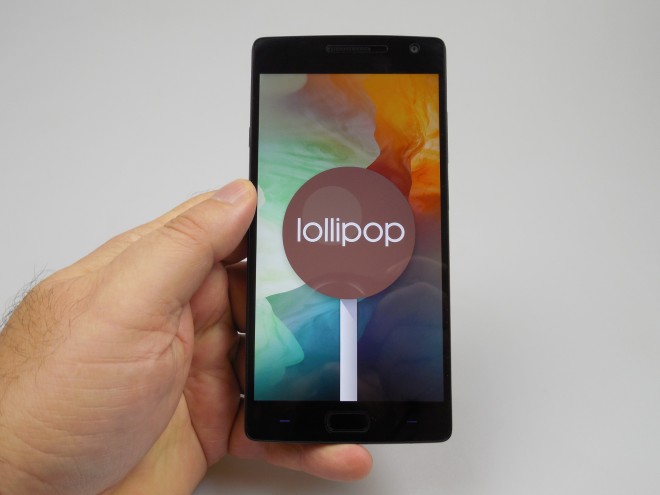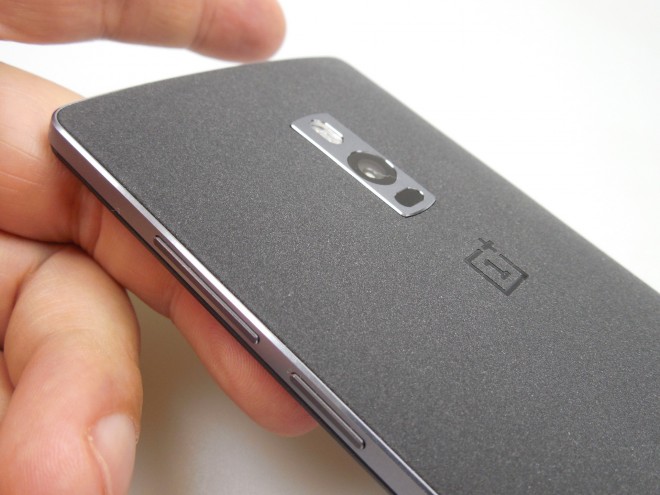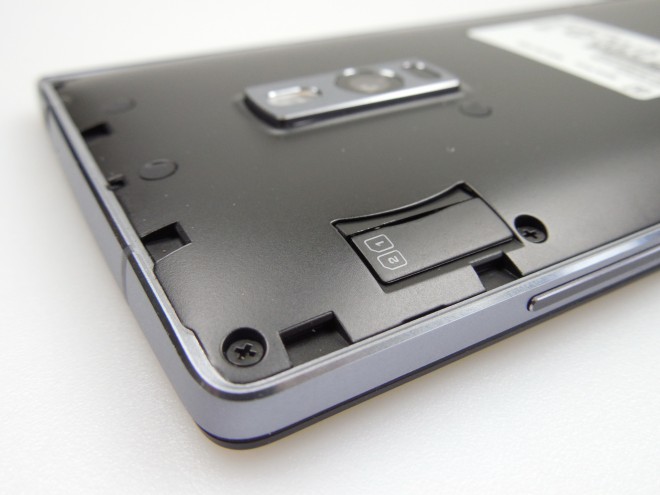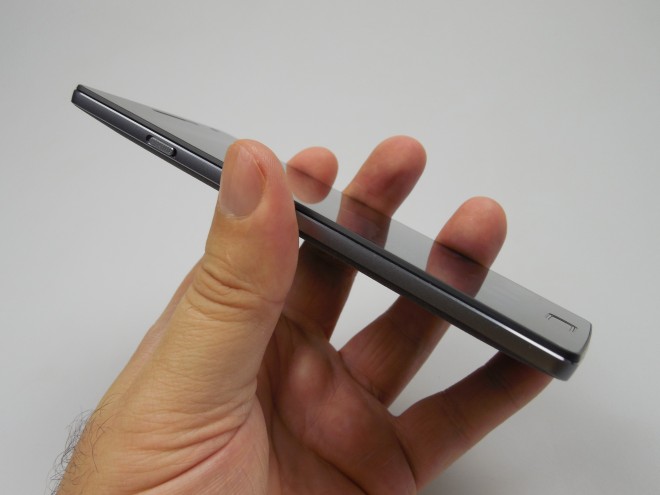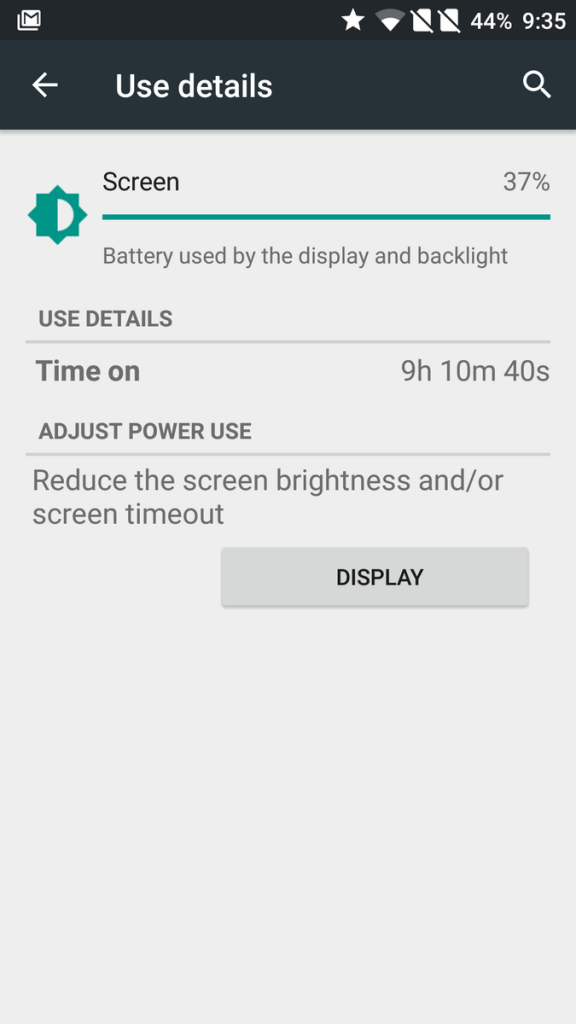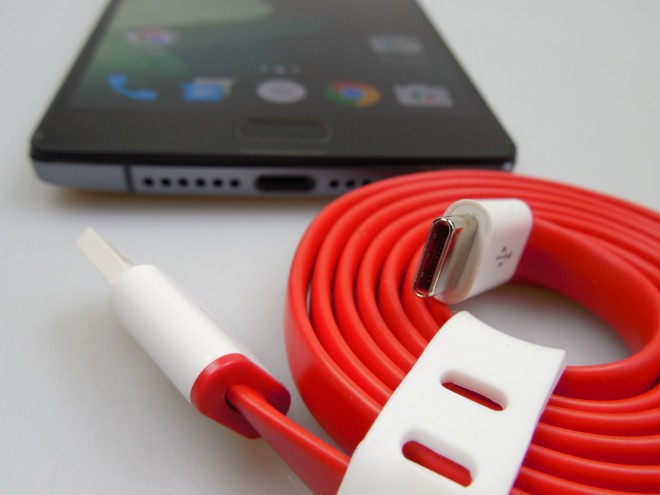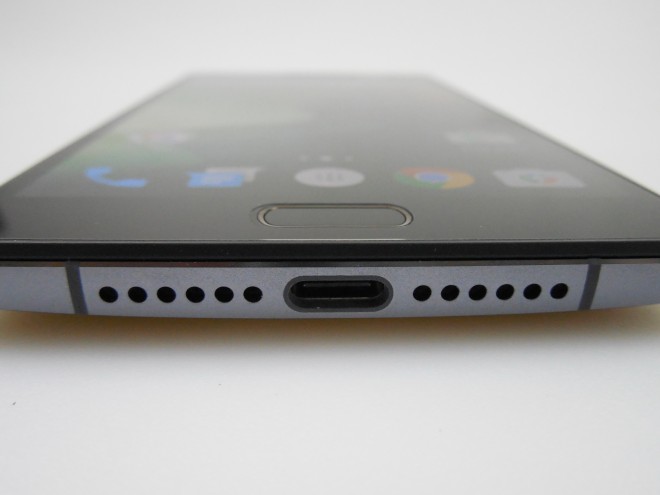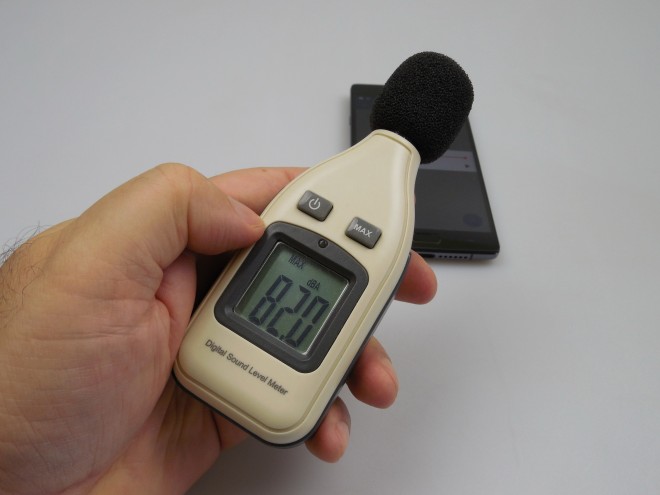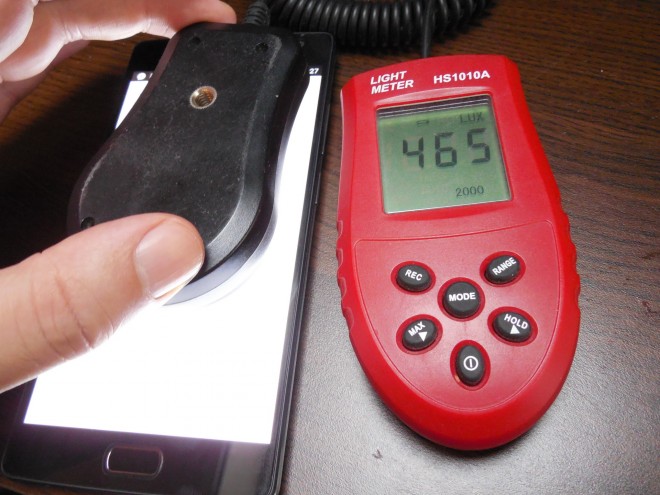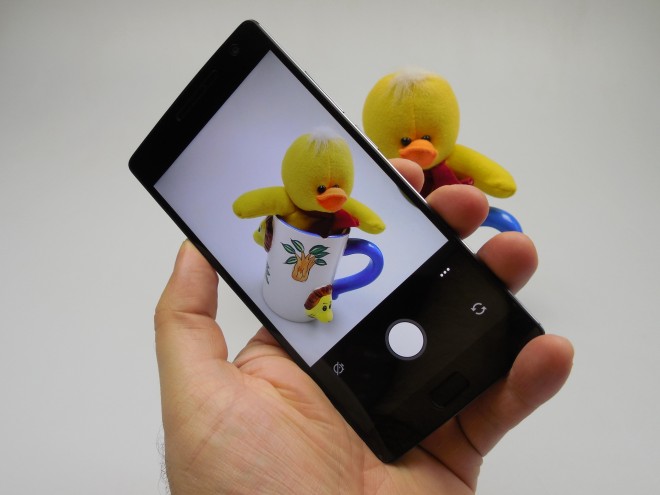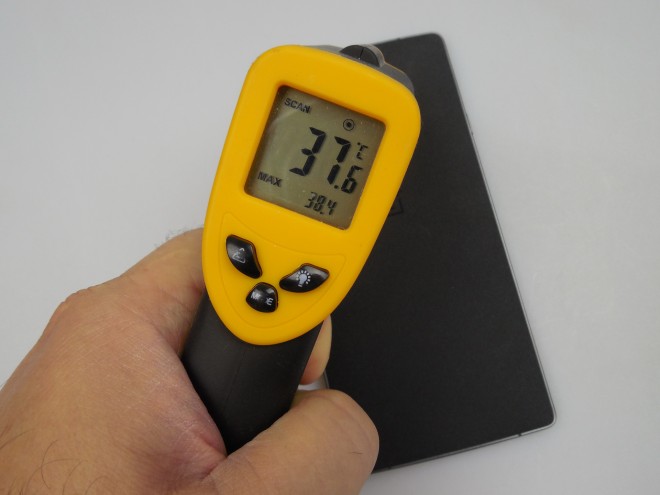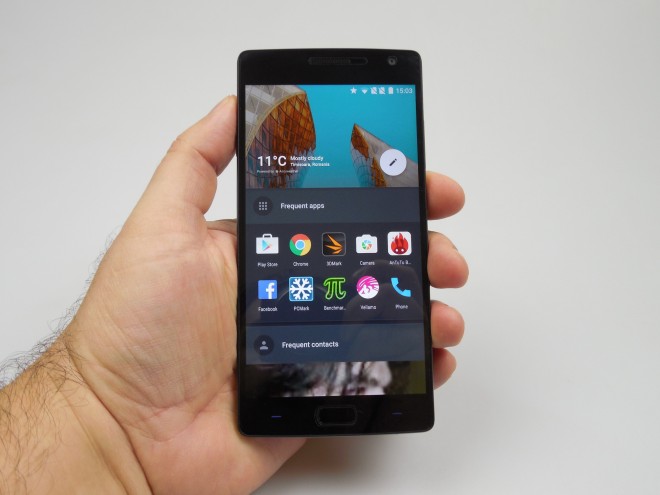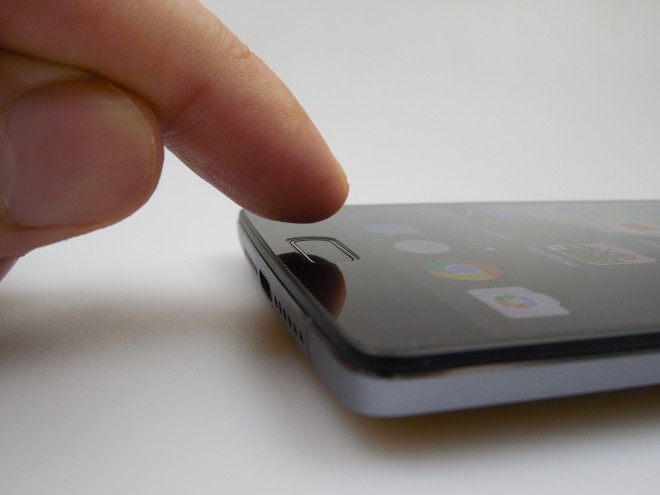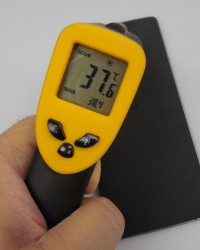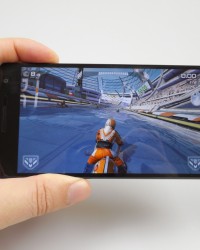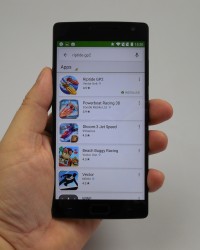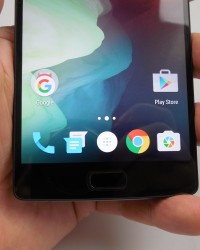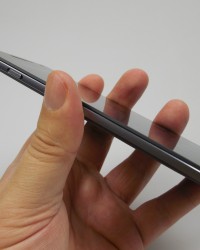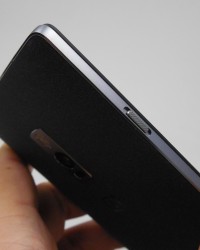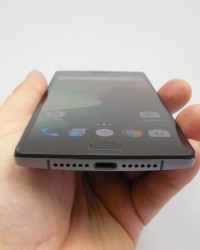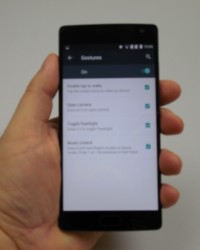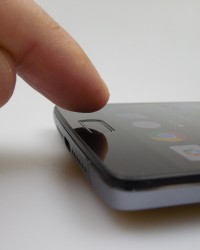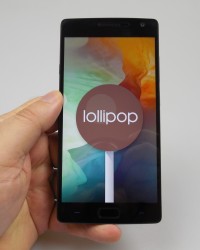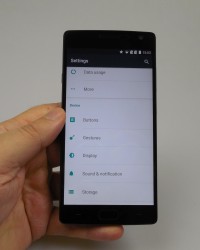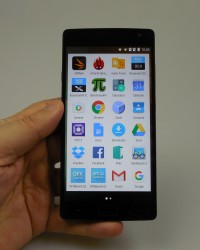OnePlus 2 is the successor to the OnePlus One, that was considered by many the “phone of the year 2014”. This means it has huge shoes to fill and just like its predecessor it’s available through an invite system. In the meantime the OnePlus One can be bought without invites and the OnePlus 2’s window of invites expanded from 24 hours to 3 days. We spent 399 euros on this model, plus an extra 24.49 euros in shipping fees.
The total adds up to 423.49 euros and we purchased the 4 GB RAM and 64 GB storage version of the device. Now let’s talk about the design! We’re dealing here with a handset that’s 9.85 mm thick and weighs 175 grams, which means it’s thicker than the 8.9 mm thick OnePlus One. It’s also 13 grams heavier. The length of the smartphone is 151.8 mm about 1 mm shorter than the OnePlus One and 7 mm shorter than the iPhone 6S Plus.
I also have to mention that this smartphone is much lighter than the 192 gram heavy iPhone 6S Plus. Finally, the product offers good grip and it adopts an aluminum-magnesium alloy frame, that’s pretty solid. One and usage is not very easy here and the back side has a sandpaper-like texture. This reminds me of the 64 GB OnePlus One, that had a similar texture.
I have to say that the OnePlus 2 is not a very comfy or aesthetically pleasing handset, since it’s massive and it’s angular frame aren’t a very nice fit to our palms. It feels cold and tough and upfront we find the selfie camera, status/notification LED, sensors, earpiece, Home button (capacitive with fingerprint scanner included) and 2 extra capacitive buttons. They aren’t marked with symbols, just with lines that lit up.
The handset has big bezels and moving to the back, we find here the sandpaper texture, that tends to gather dirt. Also at the back there’s the main camera, laser AF mechanism and dual LED flash. The camera has a strange placement, being much lower than usual at the center back side. If you remove the back cover (which is not easy to do), you will reach the non removable battery and two nano SIMs on a single tray.
At the top there’s the audio jack and microphone, plus an antenna cutout, while at the bottom we find the USB Type C port, speakers (only the right grille holds a speaker, while the left one includes the microphone probably). There are also 2 antenna cutouts in this area. To the left there’s the brand new Alert Slider, used to switch notification priority and interruptions, while on the right there are the Power and volume buttons. All these buttons are metallic and offer an OK feedback.
The smartphone feels solid, but the back texture is strange and the overall look is not very eye-pleasing. Luckily the back cover is replaceable with nicer covers, that make it more fashionable. I find the Nexus 6P to be much prettier, to be honest. Now let’s talk hardware! OnePlus 2 packs a 5.5 inch LCD in cell display, with a Full HD resolution and 401 ppi density.
Inside the handset there’s the octa core Snapdragon 810 processor, underclocked at 1.8 GHz compared the previous versions. This is version 2.1 of the CPU, that gets rid of overheating. Specs also include an Adreno 430 GPU, 3 or 4 GB of LPDDR4 RAM, 16 or 64 GB of storage of the eMMC kind and without a microSD card slot in the mix. At the back there’s a 13 megapixel shooter, with dual LED flash, while upfront there’s a 5 MP camera.
On the connectivity front here are the options: WiFi dual band a/b/g/n/ac, Bluetooth 4.1, GPS, Glonass, USB Type C, LTE Cat 4 and there’s no NFC. Sensors are as follows: accelerometer, gyroscope, proximity sensor, ambient light sensor and fingerprint sensor. Finally, this handset brings dual microphones, a speaker and a 3300 mAh Li-Po battery, that increases the capacity of 3100 mAh from the OnePlus One.
In our test, that involves HD video playback in a loop with WiFi on and brightness at 200 LUX, we achieved 9 hours and 10 minutes of playback, which is OK but not groundbreaking. I’ve seen better results on 2014 flagships. We did beat the OnePlus One’s 8 hours and 54 minutes, the Samsung Galaxy A5 (9 hours) or the LG G4 (8 hours and 55 minutes). We did score below the Samsung Galaxy Note 3 (9 hours and 30 minutes), Microsoft Lumia 640 XL LTE (9 hours and 49 minutes) and HTC One M8 (10 hours and 15 minutes).
We also did a PCMark test, that simulates continuous usage and scored 6 hours and 25 minutes here, which is also good, but I’ve seen better again. OnePlus scored 5 hours and 15 minutes in the same test, while the ASUS ZenFone 2 achieved 5 hours and 45 minutes and the LG G4 just 5 hours and 19 minutes. Other models that surpassed the OnePlus 2 are: Samsung Galaxy A5 (6 hours and 51 minutes), Samsung Galaxy S6 Edge (6 hours and 41 minutes) and Samsung Galaxy S6 (7 hours and 6 minutes).
Charging lasts 2 hours and 13 minutes here, which is almost double from the OnePlus One, that needed 1 hour and 15 minutes to juice up. At least, this phone chargers faster than the HTC One M8 (2 hours and 30 minutes), iPhone 6S (2 hours and 35 minutes) and Huawei P8 Lite (2 hours and 41 minutes). Models that charge faster are Huawei Honor 6 (2 hours), Huawei Mate S (1 hour and 59 minutes) and Samsung Galaxy S6 (1 hour and 10 minutes).
The fault for the longer charge of the OnePlus 2 belongs to the USB Type C port, that doesn’t have fast charge support yet. Settings offer access to a Battery Saver feature, that can just be turned on and have a percentage for auto activation selected. It reduces performance, limits vibration and sets background data to off. You can also opt for a dark theme to save more power.
One last mention here goes out to gaming: we used the OnePlus 2 for 2 hours to play MineCraft Story Mode and lost 35% of battery, so the device is good enough for about 6 hours of gaming. And now we can discuss acoustics.
This handset doesn’t come with headphones bundled, so you have to rely only on its single speaker at the bottom. Play Music is the music player of choice here, with an extra app associated called Audio Tuner. This one is a very capable equalizer app, with options related to music genres, 10 frequency channel sliders and extra sliders like Maxx Bass, Maxx Treble, Maxx Space, Maxx Dialog and Balance.
Those options can be altered with profiles like Movie, Music or Game. The acoustic experience brings a loud and clear volume, plus a good guitar reproduction, OK bass and no distortion. There’s no FM radio here and during our decibelmeter test, we achieved 82 dBA at the front and back. This is waaay below the OnePlus One, that achieved 90.5 dBA last year and remains one of the loudest phone we’ve tested.
We are also below the LG G4’s 87.8 dBA or the HTC One M9 (86.9 dBA). At least we surpassed the Huawei Honor 6 (81 dBA), Huawei P8 (81.2 dBA) and Huawei Mate S (80.7 dBA). The audio is OK, but it could be louder and we certainly like that equalizer. Now as far as the screen goes, this is a 5.5 inch IPS LCD with a Full HD resolution, just like the OnePlus One had.
It brings in cell technology this time and the viewing experience is bright and crisp, plus colors are a bit cold and the view angles are wide. Contrast is good and so is sunlight legibility. We used the Photos app to play video and the pixels of the screen here are RGB Stripe ones, in case you were wondering. We also tested the screen with a luxmeter and achieved 465 LUX units, which means it’s pretty bright.
We surpassed the LG G4’s 432 LUX, OnePlus One and its 404 LUX or Huawei Mate S (455 LUX). Of course, there are brighter phones out there, like the Galaxy S5 (480 LUX), Allview P8 Energy (471 LUX) and iPhone 6 (570 LUX). The screen is quite good and it has special settings like Color Balance, a slider that makes the image cooler or warmer Adaptive Brightness and font options.
Now it’s time to have a glance at the camera. OnePlus 2 comes packing a 13 megapixel main shooter with laser autofocus, dual LED flash, 6 lenses and OIS. It also has F/2.0 aperture and 1.3 micron pixels. Laser Focus is supposed to offer 0.2 second focusing and the sensor available here is a 1/2.6 inch unit, an Omnivision OV13860 unit, able to shoot 4K video and slow motion 720p 120 FPS clips.
Upfront there’s a 5 MP camera. The camera app opens up reasonably fast and the app seems inspired by stock Lollipop. With a swipe to the right of the UI we trigger the Modes area, that includes Time Lapse, Slow Mo, HDR, Photo, Video, Manual and Panorama. Other options include Location, Shutter Sound and Grid, plus resolution (12.4 MP in 4:3, 7.9 MP in 16:9 and 9.3 MP in 1:1).
In Photo mode you can activate HDR, Beauty or Clear Image, that takes 10 pictures, combines them and offers a shot with improved clarity. Timer and flash options are laso here, while the video mode offers options like 4K, Full HD or HD. Manual mode brings a few semicircular sliders, with functions like Focus (macro to infinity), Shutter (1/8000 seconds to 30 seconds), that’s more generous than the one from the LG G4 (1/6000 seconds to 30 seconds).
Then there’s White Balance and ISO up to 1600. In the manual mode you can move around the frames for metering and exposure, while in Normal mode you can use a circular slider to tweak exposure. I prefer vertical or horizontal sliders and I’m not a very big fan of this camera app. The camera itself has fast focus, fast picture taking, but takes a long time to focus in closeups and macro situations.
There’s also a tendency to over expose shots and the zoom is fluid. The gallery includes over 200 pictures and we have both a day time gallery, some shots in the sunset and a night time gallery. We start off with inside shots, taken inside a Starbucks and feeling a bit on the cold side. We also did an indoor selfie, that was yellow-ish. Shots taken before sunset had OK clarity and colors, but some of them were slightly moved or overexposed.
Panorama was not very clear in these conditions and we registered those problems with the macro shots. Details were good in closeups that were made and Clean Image tended to oversharpen things. The statues we photographed before sunset had a good texture caught on camera, although some of them were overexposed. HDR worked fine, highlighting the last lights of the day.
The malleable focus allowed us to create bokeh effects in those shots of a rosebud. The flash proved powerful when the sun finally set. Indoor shots taken inside a mall gave us too vivid colors, too much brightness but also crisp images. Now we move to the sunny day that followed, with good details when zooming into landscape shots. Colors were also great and much more realistic than those of the OnePlus One shots.
Now the Panorama looked fine, but it was taken vertically, which I don’t like and had a modest resolution: 6880 x 1832 pixels. Colors were good, as were the exposure, white balance and focus. Some strange exposure shots happened still even in full daylight. This time we also pulled off some great closeups of flowers. The selfie was so good, that it instantly made me think of the nice selfies I took with the Galaxy S6.
Skin and hair texture were perfect and the background was very clear. Then we reached an area with shade and glossy toys, that were also well captured on camera. Leaves had great texture and we had some nice focus play with those flowers. Compared to OnePlus One, the OnePlus 2 has better colors and details in landscape shots. It could even go ahead and do battle with the LG G4 during the day time.
It’s also about 10% inferior compared to the Samsung Galaxy S6 Edge. Those few overexposed, white and blurry shots spoil the otherwise nice looking gallery. During the night time we took some shots in front of a mall, with good lightning and I noticed that the brightness of the pictures is very good, even with the flash off. The flash is very powerful and colors are realistic.
Street lights have big halos and there’s no yellow hue during the night. We also played with the shutter speed, with values like 6, 8 or 10 seconds. The images did light up, but not as much as on the LG G4. Closeups of flowers look perfect in the night, with the flash on. This camera even feels a bit better than the Galaxy S6 at night and it’s clearly above the OnePlus One in this area, plus very close to the LG G4, if not its equal.
Videos were taken in 4K, Full HD, 720p slow motion at 120 FPS, in MP4 format. The first video we did was a Full HD one at 23 FPS, with 20 Mbps bitrate and some focus problems. It also suffered from motion blur and wasn’t very clear. Then we did a 4K video with 42 Mbps bitrate, focus problems again and OK clarity and colors. The constant refocusing was annoying and that problem manifested itself in the many clips we took.
The third video had the same problem and also added detail loss when zooming in. Motion blur continued and then we moved to the park/sunny day conditions. Here we had some burnt clips, a reasonably good slow motion vid and we tested the OIS with not so impressive results. The microphones also have problems with the wind it seems. The 4K video we did last looked good though…
I’d say that the video capture here is underwhelming, just like it happened with the LG G4 a few months ago. There’s too much refocusing and motion blur and in spite of that, overall the image is better than the OnePlus One and less shaky, if you can believe it. We’re miles away from models like the Galaxy A5 and LG G Flex 2 in terms of video capture.
We also did two night time video captures, with frame rate dropped to 19 FPS, a bit of blur and motion and blur included. The video with flash on had good colors, some grain and that refocus again. Overall, drawing a line here, the camera is an improvement from the OnePlus One, especially in terms of colors and details. Selfies are great, but the filming remains a letdown.
Editing is done with color, light options, crop, rotate and filters. We move on to performance testing, where we played the game Riptide GP2 for 15 minutes, reaching a temperature of 38.4 degrees Celsius, which means this model doesn’t overheat. The web browser offered here is Chrome, that’s fast enough and we also get the stock Lollipop keyboard, that’s comfy.
The connectivity bit of the review involved testing the phone calls, with decent volume, but also a bit of a metallic sound during calls. This dual SIM phone has nano SIM slots, no NFC and Speed Dial functionality. The Alert Slider has the following modes: All Notifications, Priority Interruptions Only or No Interruptions. The microphones do a good job at noise canceling.
Now it’s time for the benchmarks, where we compared the OnePlus 2 with the OnePlus One, HTC One M9, LG G4 and Samsung Galaxy S6. This is a battle between Snapdragon 810 version 2.1 + 4 GB RAM versus, Snapdragon 801 + 3GB RAM, Snapdragon 810 v1.0 + 3 GB RAM versus Snapdragon 808 + 3 GB RAM and Exynos 7420 + 3 GB RAM. Here are the results:
Quadrant:
OnePlus 2: 29693
OnePlus One: 24429
HTC One M9: 28393
LG G4: 17697
Samsung Galaxy S6: 36419
AnTuTu:
OnePlus 2: 61784
OnePlus One: 37421
HTC One M9: 52098
LG G4: 48198
Samsung Galaxy S6: 68079
NenaMark:
OnePlus 2: 60.3 FPS
OnePlus One: 63 FPS
HTC One M9: 59.9 FPS
LG G4: 60.1 FPS
Samsung Galaxy S6: 59.4 FPS
Vellamo:
OnePlus 2: 3125
OnePlus One: 3002
HTC One M9: 2971
LG G4: 3652
Samsung Galaxy S6: 3504
3DMark:
OnePlus 2: 23188
OnePlus One: 19397
HTC One M9: 21577
LG G4: 18228
Samsung Galaxy S6: 22141
GeekBench 3:
OnePlus 2: 801/3830
OnePlus One: 969/2626
HTC One M9: 1007/3843
LG G4: 1138/2996
Samsung Galaxy S6: 1477/5007
GFXBench:
OnePlus 2: 40 FPS
OnePlus One: 28.4 FPS
HTC One M9: 26 FPS
LG G4: 32 FPS
Samsung Galaxy S6: 35 FPS
SpeedTest:
OnePlus 2: 25/29 Mbps
OnePlus One: 26/22 Mbps
HTC One M9: 29/27 Mbps
LG G4: 22/22 Mbps
Samsung Galaxy S6: X
BrowserMark:
OnePlus 2: 1353
OnePlus One: 1368
HTC One M9: 1658
LG G4: 2093
Samsung Galaxy S6: 2724
SunSpider:
OnePlus 2: 1353
OnePlus One: 1048
HTC One M9: 1174
LG G4: 517
Samsung Galaxy S6: 528
BaseMark X:
OnePlus 2: 34065
OnePlus One: 24332
HTC One M9: 17891
LG G4: 25188
Samsung Galaxy S6: 38721
LinPack:
OnePlus 2: 238.84/420.62 MFLOPS
OnePlus One: X
HTC One M9: 598/651
LG G4: 355/538
Samsung Galaxy S6: 607/664
Base OS 2:
OnePlus 2: 1333
OnePlus One: X
HTC One M9: X
LG G4: 1483
Samsung Galaxy S6: X
Overall, the OnePlus 2 wind 2 out of 13 tests and versus the OnePlus One it wins 8 out of 11 benchmarks. At least it clearly surpasses the devices with Snapdragon 808 and Snapdragon 810 v1.0 processors in the main benchmarks. The device doesn’t have any lag and runs Riptide GP2 like a charm. On the OS and UI front, there’s no more Cyanogen here, instead we get Oxygen OS 2.0 on top of Lollipop. This is basically a very light skin on top of Android, with minimal customization.
The main novelty is something called Shelf, that’s sort of a Google Now rival, placed on the leftmost homescreen. It lists the weather, a header image and most frequently accessed apps, plus contacts. This has a lot of potential for the future, but for now it’s not much of a feature. If you keep the screen pressed, you can access the wallpapers, widgets (stock ones) and Settings area (icon pack, app drawer grid size and enable shelf). The Recents section shows the apps listed as a carousel for the multitasking thingie.
The dropdown area is pretty much stock, with notification, brightness slider and Quick Settings. The Settings portion has features for virtual Android buttons, in case you want them to replace the capacitive ones and you can also associate apps and functions to various presses of the capacitive buttons. A long press or double press can open the camera, Music or other apps for example and that applies to all 3 buttons. Gestures are also here (double tap to wake and draw an “O” for the camera” and more).
Then we tested the fingerprint scanner, that’s only available if you select a password lock first. Unlike other scanners, this one unlocks the device from the standby screen, it doesn’t need you to activate the screen first. The scanner is fast and accurate and can identify the finger even from a partial or side position. Finally, you can tweak the notification LED color and activate the Dark Mode.
And now let’s see the preinstalled app list, which luckily doesn’t offer any bloatware:
Audio Tuner
Calculator
Calendar
Camera
Chrome
Clock
Contacts
Docs
Downloads
Drive
Files
Gmail
Google
Google Settings
Google+
Hangouts
Keep
Maps
Messenger
Phone
Photos
Play Suite
Sheets
Slides
Swiftkey
Voice Search
YouTube
There’s no bloatware here, but I totally regret the lack of customization, that was present on the OnePlus One thanks to CyanogenMod. And now it’s time for the verdict.
Here are the Pros:
battery is OK, but could be better
nice equalizer
OK acoustics
bright screen
very good selfie and low light capture
good pictures and good details in day time shots
no overheating
no lag
no bloatware
fast and fluid UI
accurate fingerprint scanner
And the Cons:
massive and ugly
long charging compared to predecessor
no NFC
poor video capture and refocus problems
less customization than OnePlus One
camera UI and capacitive buttons aren’t likable
As you know we don’t give grades anymore to handsets, so I’m going to say that I like the very “lite” software here, pretty close to stock Lollipop, but I miss the customization of CyanogenMod. The screen and camera are good, but the video capture is not and the design is quite unpleasant. There’s no lag or bloatware and the price is 200 euros less than the big brand flagships this year, which is a good thing. Overall, OnePlus 2 is the kind of phone that may be bought by people who want good features, but don’t want a phone to show off to their friends, because it’s not very pretty.


